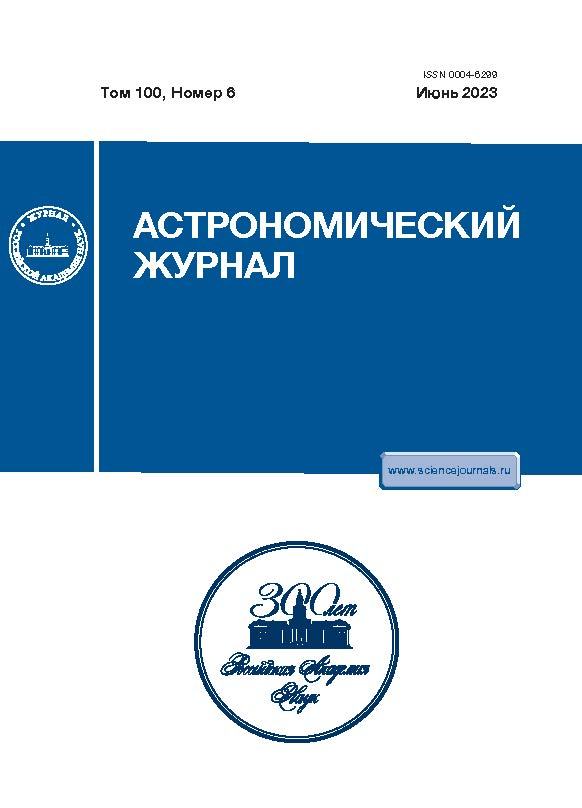Method of Circular Gaussian Rings in Perturbation Theory
- 作者: Kondratyev B.P.1,2, Kornoukhov V.S.1
-
隶属关系:
- Sternberg State Astronomical Institute, Moscow State University
- Central (Pulkovo) Astronomical Observatory, Russian Academy of Sciences
- 期: 卷 100, 编号 6 (2023)
- 页面: 524-534
- 栏目: Articles
- URL: https://ruspoj.com/0004-6299/article/view/647530
- DOI: https://doi.org/10.31857/S0004629923060051
- EDN: https://elibrary.ru/ZGDTCX
- ID: 647530
如何引用文章
详细
An extended approach to the model of circular Gaussian rings is developed to study the secular evolution of the orbits of two planets under the influence of mutual gravitational perturbation. The orbits of the planets have a small mutual inclination angle and are represented by circular rings, on which the masses, semimajor axes and inclination angles of the orbits, as well as the orbital angular momenta of the planets are transferred. The role of the perturbation function in the problem is played by the mutual gravitational energy of the rings, which is obtained in integral form and as a series in powers of slope angles. The coefficients of the series are expressed in terms of elliptic integrals. The method for the first time considers the discrepancy between the nodes of the planets’ orbits and has been developed in two versions: (i) with a large and (ii) small angles between the nodes of the orbits. For each of these options, systems of 4 differential equations describing the secular evolution of orbits are compiled and solved in the final analytical form. It is proved that the angle of mutual inclination of the orbits remains constant in the process of evolution in both cases. Option (i) is tested on the example of the Sun–Jupiter–Saturn; option (ii) is tested on the evolution of orbits of exoplanets Kepler-10b and Kepler-10c. For both systems, the precession parameters were calculated and the diagrams were plotted.
作者简介
B. Kondratyev
Sternberg State Astronomical Institute, Moscow State University; Central (Pulkovo) Astronomical Observatory, Russian Academy of Sciences
Email: work@boris-kondratyev.ru
Moscow, Russia; St. Petersburg, Russia
V. Kornoukhov
Sternberg State Astronomical Institute, Moscow State University
编辑信件的主要联系方式.
Email: work@boris-kondratyev.ru
Moscow, Russia
参考
- Г. Н. Дубошин, Небесная механика. Основные задачи и методы (М.: Наука, 1975).
- М. Ф. Субботин, Введение в теоретическую астрономию (М.: Наука, 1968).
- J. L. Laskar, Astron. and Astrophys. 198, 341 (1988).
- J. L. Simon, P. Bretagnon, J. Chapront, et al., Astron. and Astrophys. 282, 663 (1994).
- К. В. Хошевников, Э. Д. Кузнецов, Астрон. вестник 41, № 4, 291 (2007).
- Б. П. Кондратьев, Астрон. вестник 46, № 5. 380 (2012).
- Б. П. Кондратьев, В. С. Корноухов, Астрон. журн. 97, №5, 408 (2020).
- B. P. Kondratyev, Monthly Not. Roy. Astron. Soc. 442, 1755 (2014).
- Б. П. Кондратьев, В. С. Корноухов, Астрон. журн. 98, №7, 571 (2021).
- Б. П. Кондратьев, Астрон. вестник 48, № 5, 396, (2014).
- Х. Альвен, Г. Аррениус, Эволюция Солнечной системы (М.: Мир, 1979).
- К. Шарлье, Небесная механика (М.: Наука, 1966).
- К. Мюррей, С. Дермотт, Динамика Солнечной системы (М.: Физматлит, 2009).
- А. П. Прудников, Ю. А. Брычков, О. И. Маричев, Интегралы и ряды (М.: Физматлит, Т. 1, 2003).
- Б. П. Кондратьев Теория потенциала. Новые методы и задачи с решениями (М.: Мир, 2007).
- V. Singh, et al., Astron. and Astrophys. 658, A132 (2022).
- N. M. Batalha, et al., Astrophys J. 729, 27 (2011).
- L. M. Weiss, L. A. Rogers, H. T. Isaacson, et al., Astrophys J. 819, 83 (2016).
- X. Dumusque, et al., arXiv: 1405.7881, 2014, [astro-ph.EP].
补充文件


















